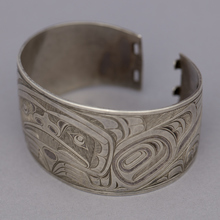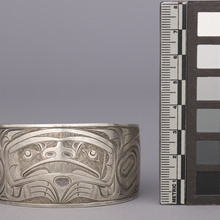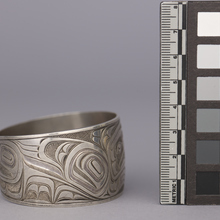Bracelet
MOA: University of British Columbia
3260/57
Silver bracelet with 'Raven-with-a-Broken-Beak' imagery. Design covers entire outer surface except for a thin border at top and bottom. Double hook-slot closure at back.
-
Iconographic Meaning
The imagery on the bracelet represents the crest of the Haida individual for whom it was made. This bracelet is engraved with an image of the Raven with a Broken Beak: an oral narrative interpreted in two-dimensional form that alludes to a dramatic episode in the adventures of the trickster-transformer Raven. The Raven’s face, with human-like features, is set in the centre; its beak and claws appear below the chin, and its feathered body wraps around each side.
-
Narrative
At some point the bracelet passed into the art market, travelling as far from home as Spain. It was later purchased by Elspeth McConnell (in Montreal), who donated it to MOA upon her death, in 2017.
-
History Of Use
Silver and gold arrived on the Northwest Coast with European explorers, first as trade items and later as coin currency paid to Indigenous cannery and sawmill workers. The earliest Haida silver bracelets, dating to about 1870, were made by artists who hammered these coins into wide bracelet shapes and engraved a motif into the metal. Although Haida silversmiths did not sign their work in the 19th and early 20th centuries, this bracelet is recognizable on the basis of the compositional style as the work of Charles Edenshaw, known as Da.a xiigang in his own community. Da.a xiigang would have begun his career making jewellery primarily for Haida people and other Indigenous relatives and individuals on the coast; later, as demand for his work grew, he also carved bracelets and other items for sale to outsiders. He was of the required high rank to have access to the knowledge and training to produce such work. Reaching artistic maturity in the mid- to late 1800s, Edenshaw brought to metalwork a formal and conceptual approach that he continued to refine, bringing greater complexity to his compositional structures and this use and control of negative space. He developed an inventive, distinctively creative practice that was contemporary to its time, and that continues to inspire Haida artists today.
- Type of Item bracelet
- Culture Haida
- Material silver metal
- Measurements height 3.3 cm, width 6.6 cm, depth 5.6 cm (overall)
- Creator Charles Edenshaw
- Previous Owner Elspeth McConnell
- Received from Elspeth McConnell
- Made in British Columbia
- Creation Date during 1890
- Ownership Date before August 12, 2017
- Acquisition Date on August 12, 2017
- Item Classes metalwork
- Condition fair
- Accession Number 3260/0057



